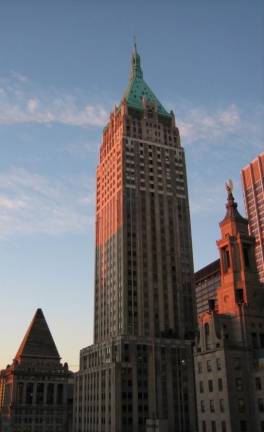A Trump Post-Presidency Tie to NYC
40 Wall Street has a storied history. Now, questions about its future

When President Donald Trump leaves the White House In January, the New York native son is set to become a Florida man.
And for good reason. Manhattan has been somewhat of a geographical poster child for the President’s base-pleasing disillusionment with “Democrat-run” cities. On top of that, he is the subject of two New-York based fraud investigations and the city’s elite have spent the past few months wondering if they should let his daughter Ivanka and son-in-law Jared back into their social circles.
But the former real-estate mogul still has strong ties to the city; among them: 40 Wall Street – The Trump Building, a towering early-twentieth-century Art-Deco style building situated in lower Manhattan.
Trump acquired the property in 1995. Today it is still under the management of the Trump Organization, run by his sons Eric and Donald Trump Jr.
“I think it was a status symbol and it was cheap,” Gwenda Blair, a Trump biographer and author of “The Trumps: Three Generations That Built an Empire,” said of the original purchase, in a phone interview with Our Town.
Trump reportedly paid around $10 million for the tower. In addition, he was able to secure a hefty $125 million from Deutsche Bank for renovations.
“An Iconic Building”
In terms of its emblematic clout, “40 Wall Street has a long, storied history,” said Ari Ginsberg, professor of entrepreneurship and management at New York University’s Stern School of Business. “It goes back all the way to the times of Burr and Hamilton and has had some very prestigious owners and tenants. It’s an iconic building without question.”
But, like many of Trump’s business ventures, the exact details are hazy. “There is some question about what he actually paid and what the actual value was,” Ginsberg said. Trump has been reported to inflate and devalue assets when it is financially advantageous.
Ginsberg added that when Trump took over the building in 1995, questionable ventures replaced the reputable businesses that historically occupied the space. Boiler rooms and penny stock sellers proliferated. The SEC once reported that the property had the highest number of unregistered broker complaints. The building still has a troubled image. In 2016 Bloomberg ran a headline highlighting the building’s odd bedfellows: “Inside Trump’s Most Valuable Tower: Felons, Dictators and Girl Scouts.”
Viewed as a whole, the property stands as a scandal-filled attempt at a 90s-era Trumpian comeback. It was, according to Ginsberg, a key part of his strategy to rebuild himself — a real estate mulligan after his financial pitfalls in the 1980s.
Myth of Success
After a contentious four years as president, Trump may need another re-do. But in terms of conducting substantive business in New York after he leaves 1600 Pennsylvania Avenue, “I think it’s close to impossible that he would have any serious engagement with [40 Wall Street], Blair said.
If Trump does come back, the city he enters will not be the city he left. The urban jungle milieu in which he was able to build and sustain the myth of his success has all but soured on the former businessman. Figures and institutions that enabled his rise now want to foreclose it.
“His brand was what you could get away with and he can’t get away with that much in New York anymore,” Blair said. “The city and state governments are not hospitable to him anymore. The financial industry is not hospitable to him anymore.”
In addition, according to Ginsberg, the Trump name itself no longer carries an appeal. If at one point the large golden letters spelling out the dynastic family name evoked the essence of big city glitz, glamour and astute business ventures, they now conjure up the image of a polarizing president. (Since 2016, all six New York buildings that held the name of “Trump Place” have decided to remove the can’t-miss letters. Structures that still bear the surname – i.e., Trump Hotel at Columbus Circle and Trump Tower on Fifth Ave – have been the sites of protests and police barricades.)
Ginsberg cited residents’ displeasure with Trump administration policies and the way in which the city and state were treated by the federal government. It is unlikely that the widespread dismay is lost on the president and those around him. Said Ginsberg: “I think he and his family have got a pretty good sense that they’re not welcome in New York City.”